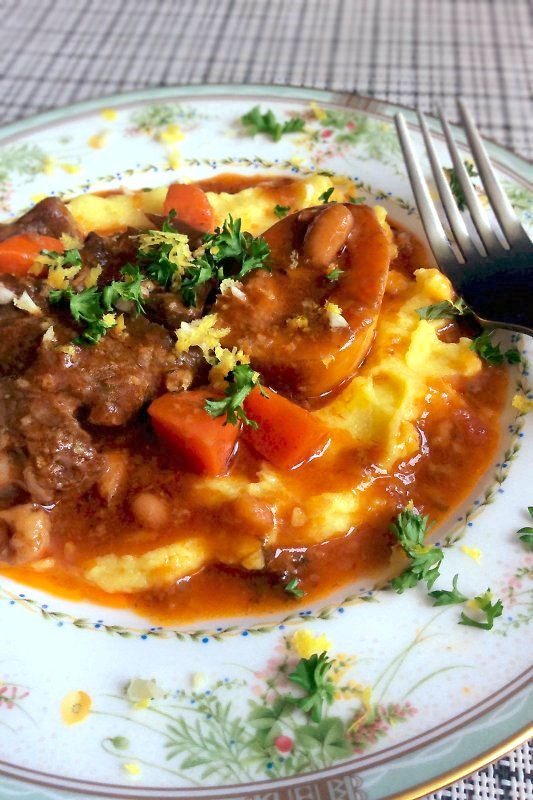When my father told his guest that I had prepared something special for lunch, I knew I had the osso buco down pat. Pa is so finicky, I had long given up trying to figure out how he comes to decide what it is he likes — little wonder Ma gave up cooking for him a long time ago — making the rare pronouncement like this music to my ears.
Osso buco literally translates to “bone with a hole,” actually cross-cut beef hind shank with marrow-filled bone at its core. The dish traditionally calls for veal/calf, although good luck insisting on that at our local purveyors’ — older beef takes longer to tenderize. If you own a pressure cooker, you are better off, if not by much, because you still have to let the osso buco sit for a day or two, just like adobo and humba, for the flavors to come together.
But the real trick to great osso buco is in the sofrito or base sauce. The beef will take however long it takes to cook, but there is only one way to make sofrito: long and slow. First you caramelize the onion, which takes at least half an hour if you’re aiming for so-so (and 15 minutes more to assuage the OC in me). Then follow carrot and celery, cooked until uniformly softened (mushy, really), which takes an additional 15 minutes or so.
There is absolutely no way of expediting good osso buco. I have just now learned that there was a scene in the TV series Desperate Housewives that perfectly sums up my feelings about the dish. The conversation is between Bree van de Kamp (Marcia Cross) and her son, Andrew (Shawn Pyfrom).
Bree: So, how’s the osso buco?
Andrew: It’s okay.
Bree: It’s okay? Andrew, I spent three hours cooking this meal. How do you think it makes me feel when you say “it’s okay” in that sullen tone?
Andrew: Who asked you to spend three hours on dinner?
Bree: Excuse me?
Andrew: Tim Harper’s Mom gets home from work, pops open a can of pork and beans, and, boom, they’re eating. Everyone’s happy.
Bree: You’d rather I serve pork and beans?
Obviously she never thought to serve them as one dish. For someone who has never subscribed to the very Tagalog practice of adding liver spread to lechon paksiw, I just knew that sweet pork and beans would go splendidly with osso buco (also, a dash of fish sauce). Let’s just say that spending more than three hours on a dish gives you time to carefully consider adding a non-traditional ingredient to it. And cook polenta as well. I had seen two or three episodes of Desperate Housewives before deciding the show was not for me, but Andrew was right: pork and beans makes everyone happy. If you want to give your usual osso buco a twist, here’s something I heartily endorse.
Osso Buco (with a twist)
Adapted from a recipe by Giada de Laurentiis. I used fresh rosemary and bay leaves for the bouquet garni, although dried works just as well. My gremolata had curly-leaf parsley instead of the traditional flat-leaf; go for the latter if you have it (I didn’t, obviously). Here the dish is served on a bed of polenta, which IMHO is not nearly as good as plain rice.
- 1½ kilos beef shank
- salt and pepper
- flour
- ⅓ cup olive oil
- 1 sprig rosemary
- 2 bay leaves
- 4 whole cloves
- 1 cup minced yellow onion
- ¼ cup minced celery
- ¼ cup minced carrot
- 2 tablespoons tomato paste
- 1½ cups dry white wine
- chicken stock
- 1 medium carrot, cubed
- 1 small can pork and beans
- fish sauce
- brown sugar
- 3 cloves garlic, finely minced
- 3 tablespoons chopped falt-leaf parsley
- 1 tablespoon grated lemon zest
For the gremolata:
- Rinse shanks and drain well. Blot out extra moisture with paper towels. Season with salt and freshly ground black pepper, then cover and marinate in the refrigerator for at least 4 hours or overnight.
- To assemble the bouquet garni wrap rosemary, bay leaves, and cloves in cheesecloth (or empty teabag) and secure with baker’s twine. Set aside.
- Dredge shanks in flour, shaking off excess. Heat up a large Dutch oven before adding 2 tablespoons of olive oil. When smoking, add shanks in a single layer (you may have to do this step in batches) and fry 3 minutes on each side, or until nicely browned all over. Remove from oil and set aside.
- Pour remaining olive oil into pot. When oil is hot (but not smoking), add minced onion and sauté. Sprinkle with a pinch of salt, turn heat down to low, and cook, stirring occasionally, until onion bits have cooked down to a deep brown mush, about 45 minutes. Add carrot and celery and continue cooking until everything is uniformly mushy, about 15 to 20 minutes. Add tomato paste and mix well.
- Return browned shanks to the pot along with the bouquet garni and dry white wine. Set heat to medium and wait until wine is reduced by half, then add enough chicken stock to just top the shanks. Cover pot and turn heat to low. Turn shanks every 30 minutes, adding more stock as necessary to keep beef covered. Meanwhile, make gremolata by throwing together in a bowl minced garlic, chopped parsley, and grated lemon zest, then set aside.
- After 2 hours, check if shanks are tender enough (meat should be falling off the bone). Season sauce with a pinch of sugar and a dash (or two) of fish sauce before adding carrot cubes and pork and beans. Cook until carrots are tender, about 10 minutes. Remove and discard bouquet garni before transferring dish to serving plate. Garnish with gremolata.



This post has no comments.
Post a Comment